SPECIAL REPORT: Kwara communities groan as erosion washes away roads, property
For a number of years communities in Ilorin South LGA of Kwara State have had to live with the menace of erosion washing away their roads and property. Usman Mustapha captures their plight and what they’ve been doing to help themselves despite government’s several failed promises.
From small potholes to deep gullies, the narrow road from Ojere/Ogidi in Ilorin South to the junction linking Gaa saka and Ita-Moh in Ilorin West Local Government Area of Kwara State, the journey which lasted over 25 minutes could have taken 10 minutes under good conditions.
Moving from one pothole to another, the commercial bike rider expressed his frustration to this reporter and said that he would stop when he reached the ‘big’ gully at Iya Biodun’s place, citing the bad condition of the place. As the bike moved past the first two communities-Oniru and Laduba, there were different gullies and bike men taking other rough but enduring paths to satisfy their customers.
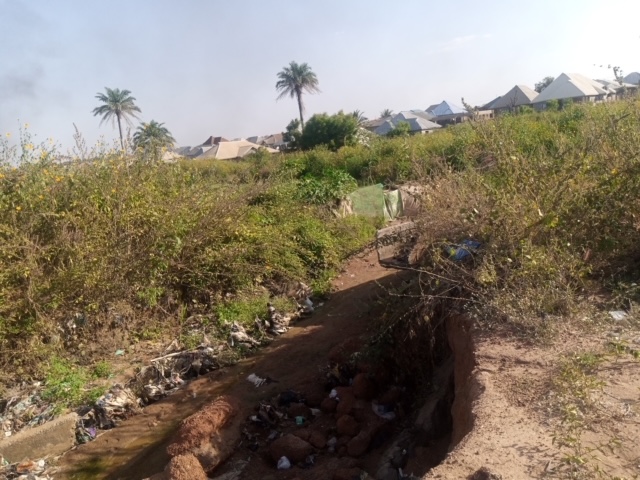
Abandoned Federal Government project in Ojere/Ogidi area of Ilorin, Kwara state
“This is the reason our people refuse to carry people going this route”, the bike man who refused to give his name began. Two different bike men had refused to take this reporter before he was able to strike a deal with this tall young man.
“When we get there, you will see for yourself. You said you came here three years ago, right?” not waiting for an answer, he continued while trailing the gutter’s side. “It’s beyond explanation. Before, we could still find means to cross to the junction but not anymore except we take ‘wrong way’ and whenever the customers insist, we take additional charges”
During the 2021 rainy season, residents of the affected communities-Olayeri Ogidi, Laduba, Ajibesin, Alawo and Idi Ape Ogidi communities in Ojere/Ogidi, Ilorin South LGA watched erosion take away their lands, properties and main road, despite the huge sums budgeted every year to rehabilitate and monitor the dilapidated road that passed to their various houses.
The Federal low cost road connecting more than five different communities to Ojere junction and Gaa saka/ Ita-moh market at the other end has always been a nightmare for residents living and plying the region. Sometimes, residents lose their property during the rainy season and experience piles of refuse during harmattan season.
On a sunny afternoon, a chubby elderly man, Baba Warder, as he is popularly known, wore his clothes after stepping out from his house as he narrated their ordeal in the last few years. Trying to adjust the position of his glasses, he asked “Have you seen the so called federal road”
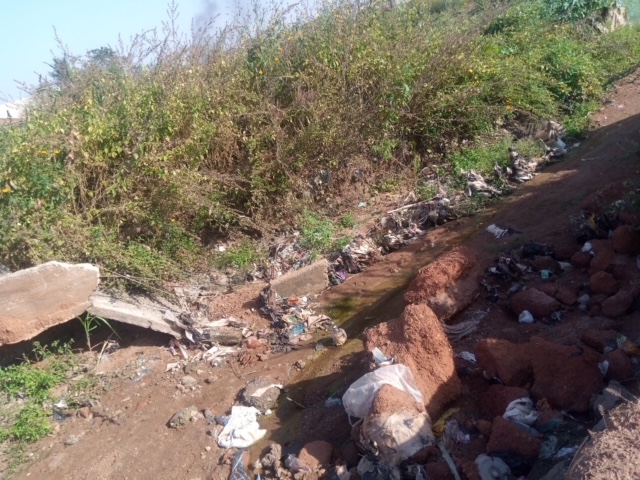
The drainage channel in Olayeri community is in disarray
“That’s the federal road constructed during the military era in late 90’s by the then minister for works”
During the military regime of Gen. Abacha, the then minister for works, Gen. Abdulkareem Adisa graded the road (now known as Ojere street) and constructed side gutters to ease the burden on people living in these communities, but could not proceed to tarring it before leaving office.
The project lasted about a decade before taking another turn. This ‘turn’ would have been prevented had it been the state and federal governments followed it up. But over the years it became as deadly as never before.
Life in Olayeri
Iya Abdulrahman, a fairly dazzling lady in her late 30s led the journey to the ‘small dam’ pointing to some of the few houses which had been flooded during the last rainy season.
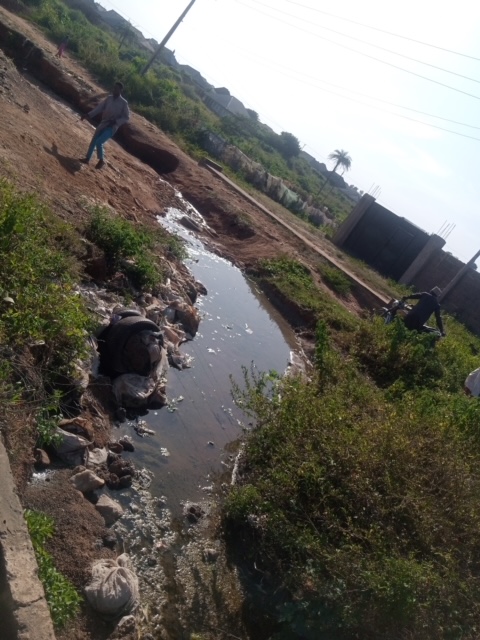
The small ‘dam’ as pointed out by Iya Abdulrahman
Life in Olayeri could be very toxic during the rainy season and dirty during harmattan period, as some residents would take advantage of the gully road to dump their refuse and garbage. This is an annual incident as confirmed by Iya Abdulrahman.
“During Covid19 period, the road which had been turned to a landfill site was taken care of by the community. They all came out, razed the site and then used the garbage to fill up the potholes and the gullies.
“But anytime rain dropped, it flooded the land causing bigger gullies through erosion coming from nearby communities. Most times, the erosion took other paths, rampaging houses and causing loss of properties”.
One could sense the level of troubles this woman has faced through her eyes. But she won’t stop hoping for a better future that will allow her to sell her products during the rainy season.
Shouting Iya Abdulrahman’s name from a far distance, Alfa Abdulqodir was battling to walk past the gully from another end.
Alfa Abdulqodir who declined to give his surname has been staying with his family in the Olayeri community for the past 10 years. At first when they packed in, cars, tricycles and bikes could all ply the road though not denying the pain the body would encounter after the short journey to their homes from Ojere Junction.
“Since like two years ago, it’s not motorable again. Last year, bikes could still pass through this road but not anymore. Even people walking by would have to step on this gutter for convenient movement or you take a U-turn and follow another path.
“It’s an endless fight with erosion every year. Normally the community did take it up every year but I guess there’s a limit to their strengths”
Endless fight with erosion
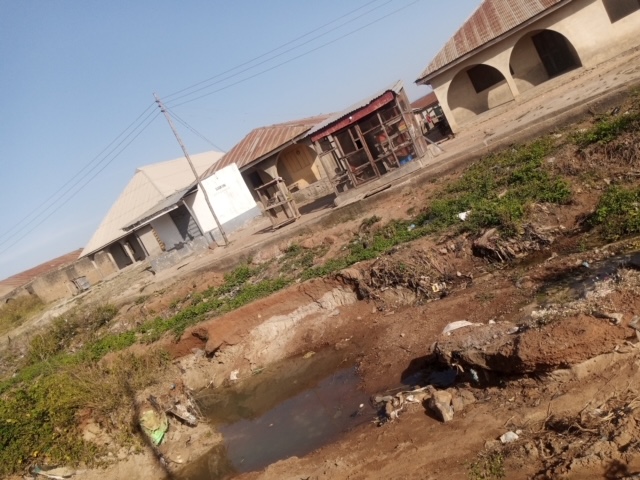
The devastated road affects some houses in Olayeri Community during rainy seasons
Beyond rendering people homeless, erosion is one of the major climatic changes that transforms different regions into deserts and unproductive lands for farming. This erosion leads to soil degradation and biodiversity.
According to the World Bank Group, Nigeria is classified as one of the ten most vulnerable countries due to the impact of climate change and industrial hazards. It’s said that, in recent times, Nigeria experienced a double shock of heavy drought in the northeast and widespread effects in nearly every part of the country in 2021.
Since September 2013, reports also have it that Nigerian government has been receiving support from the World Bank to fulfill close measures and fund the erosion affected states under the eight year $500 million Nigeria Erosion and Watershed Management report.
But that wouldn’t provide a remedy to the issue of erosion in some parts of the country as erosion keeps digging gullies on Nigeria’s roads.
“It has always been like that since I moved here”, Oniyepe Magaji, a provision seller who owns a small kiosk at the roadside told this reporter.
”Anytime it’s raining, the flood is as tall as you (reporter) putting residents into fear”
A lifelong Traffic
“The everyday traffic can be prevented if our street is fine and free of gullies” Baba Adaabale mentioned to this reporter.
The usual traffic that emanates from the poor nature of the Ojere street is a testimony of how important the ‘abandoned’ road is. Ranging from economic importance, it eases the livelihood of transporters and residents going to Ita moh, Gaa Saka and Estate (phase 1&2) as the road can be easily plied without bothering to go through the hardship of traffic on the main road of Ogidi-Okolowo.
“Sometimes, the traffic could be long and irritating at the main road but this road (Ojere/Olayele street) leads to some of the destinations of these transporters.
“For example, people going to Ita moh, Gaa Saka, Madi, Mandate can easily ply this street if the road is fine but it’s not. The traffic causes lots of headache for those driving home”
“Abandoned or Not; we are exhausted”
It has been a continuous struggle by youths and residents against the government. Having gone to the Government’s House and ministry of works on different occasions to lodge complains about the nature of their road, the communities involved-Olayeri Ogidi, Laduba, Ajibesin, Alawo and Idi Ape Ogidi decided to contribute money to fight the erosion and provide a temporary solution to the problem until this year when it required more than what they could afford.
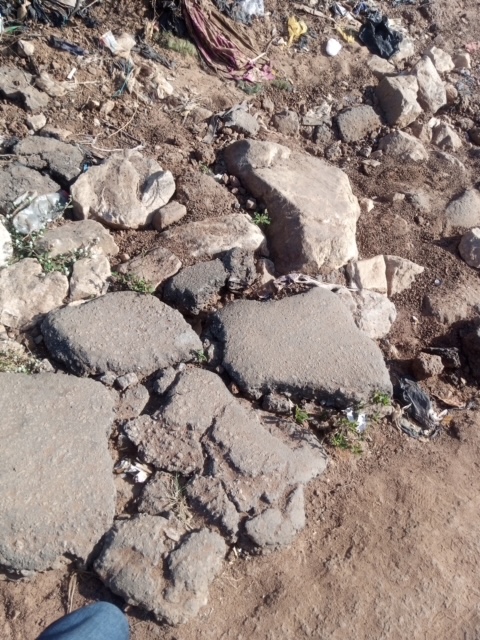
Self-help efforts made by the affected communities
“If I can remember, we spent N300,000 to purchase stone alone just to fill the gullies. Sometimes, some influential people amongst us took the responsibility of buying sands and cement. All these affected communities gathered to rehabilitate it last year spending quite an amount of money, but the erosion won’t stop taking another turn”.
These were the words of Baba Adaabale of the Olayeri community.
“When we couldn’t task ourselves any longer, we gave up” Baba Warder also replied on how long the community had been spending on the project.
“We have spent millions of naira over the years just to keep the erosion away from our land but it keeps flooding all our efforts and sometimes our properties. “They (Ministry of works) said it’s an abandoned project that the contract has already been given out but we don’t know the contractor.
“If Federal Government is not ready to do it, state government should help and they will claim it later”
Futile Attempts
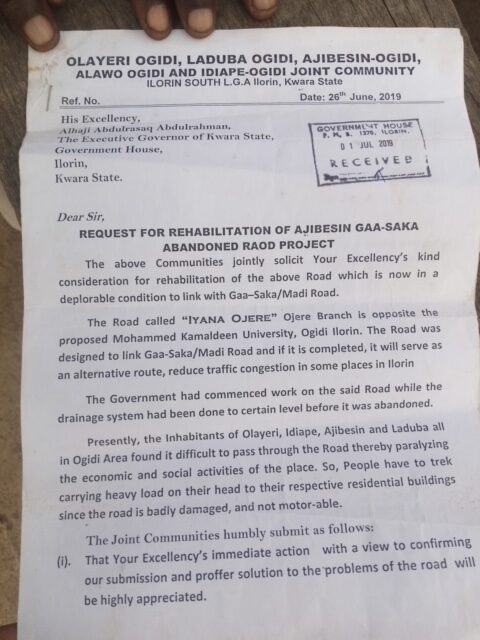
Letter directed to the state governor by Olayeri, Laduba, Ajibesin, Alawo and Idiape Joint Communities Committee
On different occasions, the Joint community committee had gone to both the state ministry and federal ministry of works to report this incident.
Dated back to 2017, the affected communities had written to the governor of Kwara State to state their plights.
This became a usual act as the government kept looking away-sometimes, they send as many as four letters in a year.
While it appeared that the last administration would not respond, the community wrote another letter on 26th of June, 2019 to the present administration demanding for rehabilitation of the road. The Governor, Abdulrazaq Abdulrahman did pay a visit to the area after receiving their letter. Bit it was for nothing.
The subject of their letters has always been ‘Request for Rehabilitation of Ajibesin Gaa Saka Abandoned Road Project.
The Chairman of the Joint Community committee, Baba Kinni of Laduba Community, said that the affected communities had their hope high when the Governor promised to see to their request. But it faded after several reminders to the governor failed to yield any result.
“There was a time this present governor came to check the road. He assured us that the government will intervene but ever since then, we have not seen anyone.
“We have written to them several times, we even submitted another one early this year but the government keeps looking away”.



